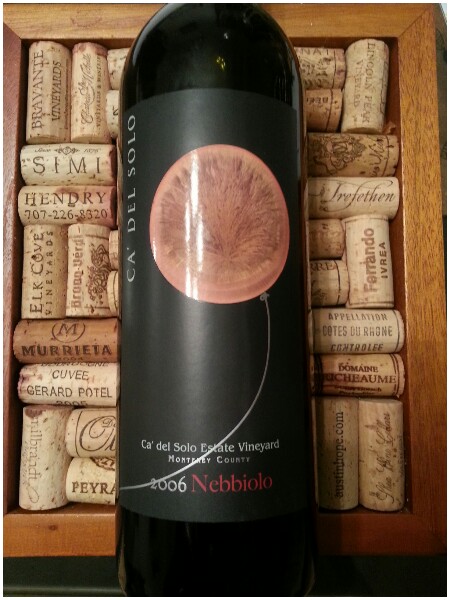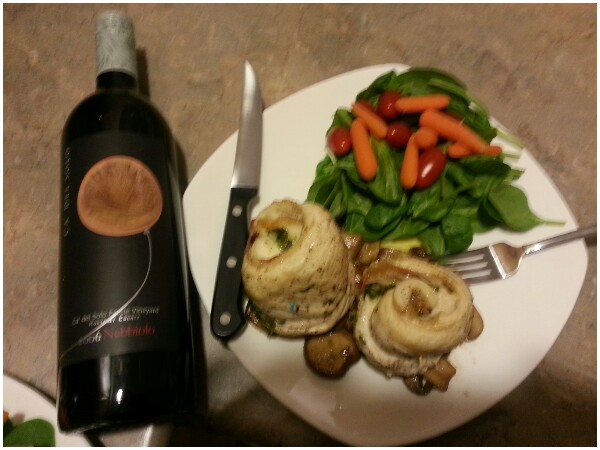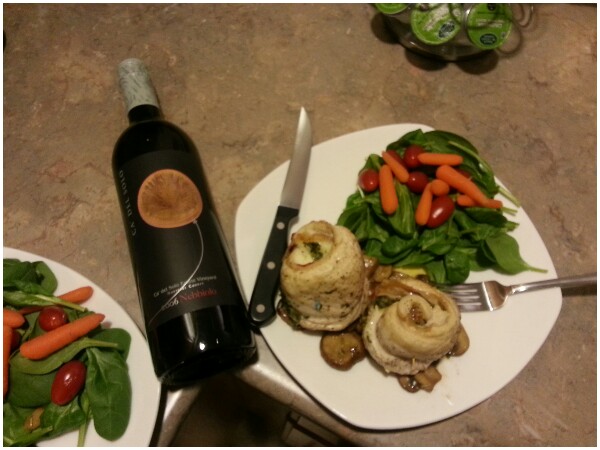 2006 Bonny Doon Ca' Del Solo Nebbiolo
2006 Bonny Doon Ca' Del Solo Nebbiolo
Last night, I had the pleasure of attending Wednesday Wine Down with a group of close friends. Afterwards, we ventured down to a new Neapolitan pizza restaurant on Saint Paul Street, called Pizzeria Verita. The pizza was excellent, and I was especially impressed with the both the selections and pricing featured on their wine list, which was mostly Italian in composition. After perusing the short, but thoughtfully composed wine list, I settled on choosing the Cantine Valpene Barbera for our table. This Barbera is a perennial favorite of mine, and it earned high praise in the small blind tasting of Barbera that I hosted this fall.
However, as I sat at the table and observed the ease with which the Barbera paired with our pizza, a nagging thought re-entered my head. Why weren't more American vintners producing wines from traditionally Italian varietals? I certainly enjoy Italian wines, but it is often fun to compare American interpretations of traditionally European grapes. However, for all the diversity and growth that America's wine culture has enjoyed over the past 30-plus years, American viticulture is still shockingly dominated by grapes that are native to France. Nearly all of our most prolific and popular grapes - Chardonnay, Cabernet Sauvignon, Pinot Noir, Sauvignon Blanc, and to some extent Syrah and Riesling - trace their origins to France. What about Italian grapes? Isn't their a devoted following for Italian wines in America? I've seen wine enthusiasts hunt down prodigious Chiantis, Brunello di Montalcinos, Barolos, and Barbarescos, along with more obscure Italian varietals, such as the red wines made from the Nerello Mascalese grape by Tenuta delle Terre Nere on Mount Etna in Sicily. Certainly, some Italian grapes are likely to be limited to their native terroir, but it is still shocking to think that our wine industry has been so heavily influenced by France to the detriment of other countries.
I am always searching for new wines, and I have a particular affinity for the obscure and esoteric. At the present moment, American wines made from Italian varietals are well described by those characteristics. The question to ask is: Why is that the case?
- Is driven by economics, and the lack of market interest for Italian varietals grown in America?
- Is there a lack of connection between the largely geographically oriented names of the famous wines of Italy, and the grapes that are used to make them? I.e., does the average American wine consumer automatically link Sangiovese to Chianti, Brunello di Montalcino, and Vino Nobile di Montepulciano? Does hearing the name of the Nebbiolo grape conjure up images of Barolo and Barbaresco?
- Is it a case of terroir? Are Italian varietals so well suited to their native micro-climates that it is too difficult to grow them in America?
- Has there been too little opportunity to prove that America has the potential to successfully produce wines from traditionally Italian varietals?
Over the last several weeks, I have made an effort to acquire any American-Italian wines that I have come across in my travels. I have not encountered many, but to date, I have acquired:
- 2007 Bonny Doon Ca' Del Solo Dolcetto
- 2006 Bonny Doon Ca' Del Solo Nebbiolo
- 2009 Bonny Doon Ca' Del Solo Muscat
- 2010 Pebble Ridge Sangiovese
- 2011 Viansa Arneis
- 2005 Amethyst Nebbiolo
I haven't had the chance to try all of these wines, but I've tasted through the Bonny Doon wines and the Pebble Ridge Sangiovese, and have been impressed. Obviously, they offer a California interpretation of these Italian varietals, but to expect them to fully imitate their Italian counterparts would be foolish, given the vast difference in terroir. However, the link to Italy was apparent in all of these wines. The 2007 Bonny Doon Ca' Del Solo Dolcetto was soft and plush, with notes of black fruits, and a hint of crushed red raspberry, while the 2009 Bonny Doon Ca' Del Solo Muscat was dry, floral, and full-bodied, with flavors of citrus and tree fruit on the palate.


The Dolcetto and the Muscat were outstanding, but the wine I was most impressed with was the 2006 Bonny Doon Ca' Del Solo Nebbiolo. Over the holidays, I prepared a meal of Prosciutto Stuffed Chicken with Mushroom Sauce, a dish that absolutely screams for a wine made from Piedmont's signature varietal. However, in homage to my roots as an American chef, I decided to experiment with an American Nebbiolo as a wine pairing. The2006 Bonny Doon Ca' Del Solo Nebbiolo was light-bodied and elegant, with Nebbiolo's signature aromas of rose petal, dried red fruits, and tar. On the palate, it was slightly more fruit forward than one might expect from a Barolo or Barbaresco, but the slight earthiness and flavors of red cherry made for a wonderful compliment to the meal.
After experiencing the quality that some American vintners are achieving with traditionally Italian varietals, I have decided to focus on drawing greater attention to this category in the weeks going forward, and hopefully explaining why there is such a prominent absence of these wines in the American marketplace. I plan to speak with American vintners working with Italian varietals, and ultimately conclude my coverage of Italian-inspired American wines with a blind panel tasting, pitting Italian-inspired American wines against their native Italian counterparts. After all, it was not until the 1976 Paris Tasting that American Chardonnay and American Cabernet Sauvignon were recognized as being able to stand as equals alongside their French counterparts. Perhaps a new tasting in the spirit of the 1976 Paris Tasting will serve to propel Italian-inspired American wines to a more prominent place in the minds of wine consumers.
Have you had any positive experiences with Italian-inspired American wines? Do you know of any American wineries focusing on Italian varietals? If so, please reach out, either in the comments section, or through the general contact form. I would like to be as inclusive as possible in determining the composition of the tasting, and in my coverage on the subject in general.